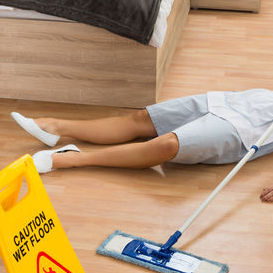Preventing Injuries
Slips, Trips, and Falls
Workplace slips, trips, and falls are common among housekeeping workers and others primarily due to exposure to wet floors.
It's important to do the following to minimize exposure to slip, trip, and fall hazards:
- maintain floors in a clean and, so far as possible, dry condition, and mats should be provided where practicable;
- place warning signs for wet floor areas where they will be seen;
- immediately clean up floors that are wet, have spills, or are cluttered;
- use housekeeping procedures such as only cleaning one side of a passageway at a time;
- make sure good lighting is provided for all halls and stairwells can help reduce accidents;
- avoid undue speed, and maintain an unobstructed view of the stairs, even if that means requesting help to manage a bulky load;
- eliminate uneven floor surfaces.
Ladder Safety
Ladders are often used by housekeeping workers in most workplaces. The frequent inspection of ladders is necessary to identify any that are damaged, need repair, or require disposal. To reduce the probability of housekeeping workers being injured by falls from ladders, employers should do the following:
- immediately remove ladders with defects from service. This includes broken or missing rungs or steps, broken or split side rails, corroded parts, or improper construction;
- ensure portable ladders are lashed, blocked, or otherwise secured as necessary to prevent displacement during use;
- ensure regular ladder inspection and reporting;
- provide warning cones or other warning devices to warn others while workers are using ladders; and
- train housekeeping workers on the safe use of ladders including the "Three-Point Control" method using only hands and feet to maintain stability.
Knowledge Check Choose the best answer for the question.
3-1. Which of the following describes the Three-Point Control method for climbing ladders?
You forgot to answer the question!

